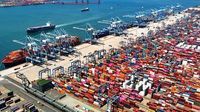In a week marked by escalating rhetoric and market turmoil, President Donald Trump and Chinese President Xi Jinping have found themselves at the center of a renewed trade standoff that threatens to upend months of diplomatic progress and rattle the global economy. The latest flashpoint? Rare earth minerals—those obscure but crucial elements that power everything from smartphones to fighter jets—and the looming threat of a sweeping 100% tariff on all Chinese imports to the United States.
The drama began on October 9, 2025, when China’s Commerce Ministry rolled out fresh export controls requiring companies to obtain government approval before exporting products containing or made with rare earth minerals. These new rules, which target batteries, semiconductors, and technologies with magnets, were met with immediate concern in Washington and beyond. According to The Wall Street Journal, China produces about 90% of the world’s rare-earth minerals and controls nearly 70% of global mining and almost 90% of processing capacity—a dominance that gives Beijing enormous leverage over international supply chains.
President Trump wasted no time in responding. On October 10, he announced the United States would impose a 100% tariff on all Chinese imports if Beijing didn’t reverse course by November 1. He also threatened to cancel a long-anticipated meeting with Xi Jinping scheduled for October 29, a move that cast a shadow over hopes for a diplomatic breakthrough. Trump’s threat, if enacted, would bring total duties on Chinese imports to a staggering 130%, rivaling the highest points of the earlier tariff war between the two countries.
The markets reacted swiftly and harshly. On the day of Trump’s announcement, the Dow Jones Industrial Average plunged 878 points (1.9%) to 45,479.60. The S&P 500 and tech-heavy Nasdaq tumbled 2.7% and 3.6%, respectively, with all three indexes suffering their worst single-day percentage drops since April. The sell-off underscored investor anxiety about the potential for a full-blown trade war and the ripple effects on global supply chains, especially those reliant on rare earths.
Yet by the weekend, the tone from the White House began to shift. On October 12, President Trump took to Truth Social with a more conciliatory message: “Don’t worry about China, it will all be fine! Highly respected President Xi just had a bad moment. He doesn’t want Depression for his country, and neither do I. The U.S.A. wants to help China, not hurt it!!!” He reiterated this sentiment to reporters aboard Air Force One, calling Xi Jinping “a great leader” and emphasizing their “great relationship.” It was a marked departure from his earlier characterization of China as “becoming very hostile.”
China, for its part, responded with both firmness and calls for dialogue. In a statement posted online by the Commerce Ministry, officials declared, “China’s stance is consistent. We do not want a tariff war but we are not afraid of one.” The ministry urged Washington to resolve differences “through dialogue” and warned that “if the U.S. side obstinately insists on its practice, China will be sure to resolutely take corresponding measures to safeguard its legitimate rights and interests.” The statement also criticized the U.S. for “frequently resorting to the threat of high tariffs,” arguing that such tactics were “not the correct way to get along with China.”
The tit-for-tat didn’t stop there. In response to new U.S. port fees on Chinese ships set to take effect October 14, China announced it would impose its own port fees on American vessels starting the same day. The back-and-forth over port fees and export controls has fueled concerns that the trade truce painstakingly negotiated over recent months could unravel, with both sides accusing the other of violating the spirit of their previous agreements.
Vice President JD Vance weighed in on the crisis during an appearance on Fox News’ “Sunday Morning Futures,” backing Trump’s hardline stance and framing the issue as a matter of national security. “It’s going to be a delicate dance, and a lot of it is going to depend on how the Chinese respond. If they respond in a highly aggressive manner, I guarantee you the President of the United States has far more cards than the People’s Republic of China,” Vance said. He went further, calling China’s dominance in key supply chains “the definition of a national emergency.”
Meanwhile, U.S. Trade Representative Jamieson Greer expressed frustration over China’s lack of transparency, telling reporters that the U.S. was “not notified” in advance of Beijing’s increased export restrictions. Chinese officials countered that “relevant countries and regions” had been informed, highlighting the ongoing communication gap between the two superpowers.
China’s Commerce Ministry sought to reassure foreign companies that export licenses for rare earths would still be granted for “legitimate civilian uses,” but warned that if the U.S. “obstinately insists on its practice,” Beijing would act to protect its interests. The ministry’s statement also pointed out that the new regulations require foreign companies to get Chinese government approval to export items containing rare earths sourced from China, regardless of where the products are manufactured. This move has hit not only American manufacturers but also European and other international firms that rely on these critical minerals for products ranging from jet engines and radar systems to electric vehicles and everyday electronics.
The uncertainty has left global markets on edge. While U.S. stock futures rebounded slightly on Sunday—Dow futures up 0.8%, S&P 500 up 1.04%, and Nasdaq up 1.34%—analysts warn that another round of tit-for-tat tariffs could undo the progress made in recent diplomatic meetings. As one commentator put it, the market is “stirred by uncertainty,” with many investors unsure whether Trump will ultimately follow through with his tariff threat ahead of the November 1 deadline.
Behind the headlines, the stakes are high for both countries. For the United States, access to rare earths is not just an economic issue but a strategic one, with implications for national security and technological innovation. For China, maintaining control over its rare earth industry is a source of global influence and a bargaining chip in broader trade negotiations. Both sides have reasons to avoid a full-scale trade war, yet neither seems willing to back down without significant concessions.
As the November 1 deadline looms, the world watches closely. The outcome of this standoff will not only shape the future of U.S.-China relations but will also have far-reaching consequences for industries and consumers around the globe. For now, all eyes are on Washington and Beijing—and, perhaps, on whether diplomacy can prevail over brinkmanship in the high-stakes arena of international trade.





